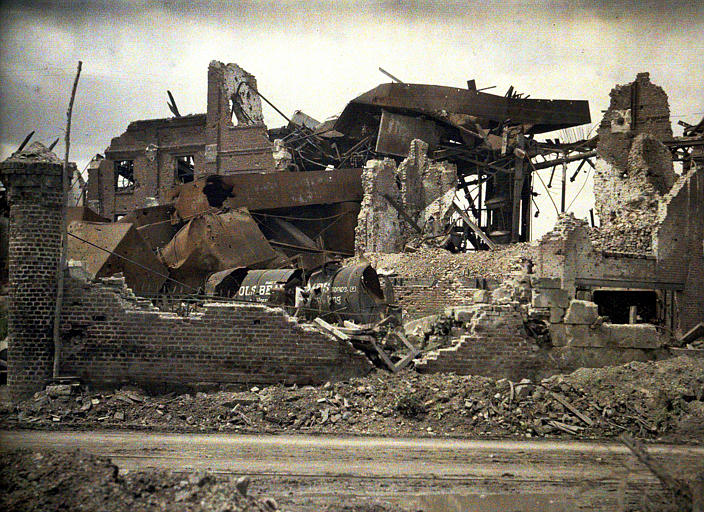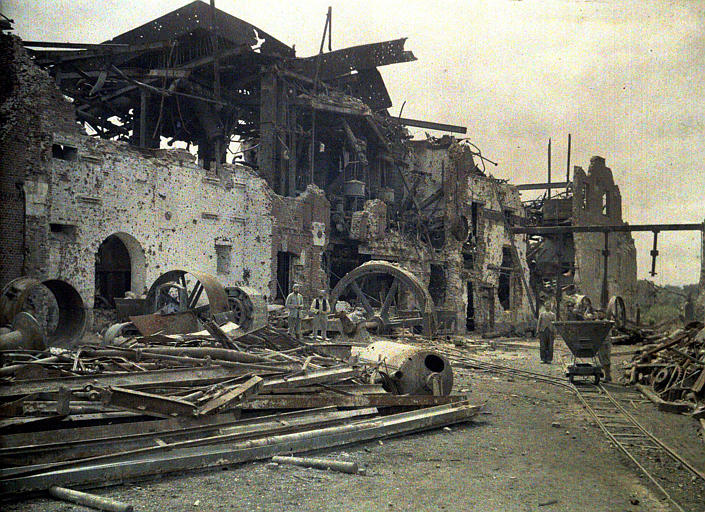Campaign History of the 151e Régiment d'Infanterie - XXVIII
~ 1918 ~
Battle of Soissons (28-31 August)
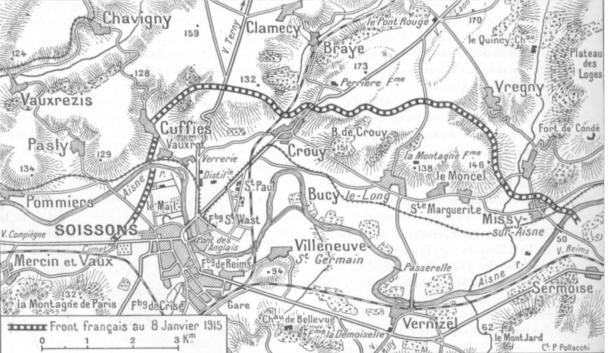
Map showing Soissons and faubourgs.
26 August: The enemy remains highly vigilant and keeps up a nervous harassing fire on Soissons and on the roads. A barrage with poison gas shells on faubourg la Crise. The division’s attack is postponed 24 hours to the 28th. The operation will be comprised of the following:
The French 10th Army is given the mission of breaking the enemy front in the direction of Lavy. The I CA on the left is composed by 59, 41, and 72 DIs, to the right by 69 and 5 DIs, with the 32 DI in reserve. It’s first objective is the windmill at Laffaux, progressing on its left to the Leury ridge, Clamecy and on its right on the Vregny ridge. The secondary mission is to take the outlets of the Ailette. The general attack is led on the left by XXX CA and on the right by XX CA. The battle will be complete when the heights of Monampteuil are taken. The movement will be echelonned over several successive days. On Aug. 28 the 69 DI is to reach the plateau to the northeast of Crouy, which is to then be continued the next day. The 151 would take the lead of the division in what would be the first true urban combat experience for the regiment. In another first, the assault was to begin with an amphibious assault to be made across the Aisne River using rafts and footbridges. Once across, the regiment would have to conduct a house-by-house and street-by-street fight that constituted some of the most intense urban combat of the war.
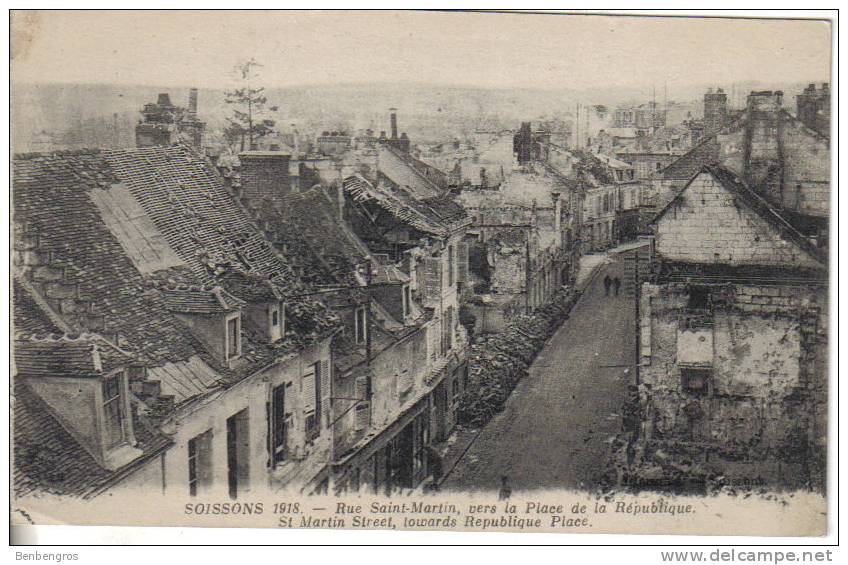

Soissons in 1918 after the battle.
Execution of the Attack: On the evening of 27 August a battalion (3 Bat.) of the 151 cross over the Pommiers bridge will be put at the disposition of the 72 DI. This battalion (3) will have as a mission to take Vauxrot, progressing on the right to the Aisne, preceded by a rolling artillery barrage to be executed by AD 72. The movement by this battalion will start at 0700 hrs. From here, it will pass back under the orders of 69 DI. Passing through Vauxrot, at 0845 hrs it will follow a rolling barrage executed by AD 69 at the speed of 100 meters every three minutes and advancing onto its next objective: left to Clemencin (left limit of the division), right the intersection of the National Road (No. 2) and the parallel 298.
At 0800 hrs, the artillery will cease firing and the two other battalions of the 151 will begin its crossing of the Aisne using boats. The center battalion (1 Bat.) will cross at two different points while the battalion on the right (2 Bat.) will cross near the railroad bridge (to the west of Villeneuve-Saint Germaine). The center battalion (1) will sweep faubourg Saint Waast after skirting it from the southeast and east, clearing out the Vauxrot distillery to the northeast of the Le Mail public gardens after skirting it from the north. This operation will be covered by a barrage in front of Saint Paul. After mopping up and being passed by the other two battalions, 1 Bat. will reform in reserve near Saint Paul.
The right battalion (2 Bat.), immediately after crossing the river, will cover the organization of Saint Médard and will ensure the mopping up operation under the protection of a barrage established on the railway and on the Tranchée du Belvedere. At 0930 hrs, the barrage of Belvedere will life and become a rolling barrage (100 meters every three minutes) so as to cover the progression of the battalion. It’s objective will be: left to the Maubeuge Road (i.e., the National Road from Paris to Maubeuge) to its intersection with the parallel 298, right to the buckle of the Aisne.
At 1200 hrs, 2 and 3 Bats. will advance under the protection of a rolling barrage (100 meters every 3 minutes) up to the northeast edges of Crouy, and Tranchées Loquetoy and Hedensburg. Beyond these objectives on which no elements must stop and up to the final objective, the speed of the rolling barrage will be 100 meters every 4 minutes. The final objective to reach is defined not from the bend in the National Road to the south of Bois de la Perière, 4090, 4494, 4888 and the northern border of Ravin de Bucy to the south of 4888.
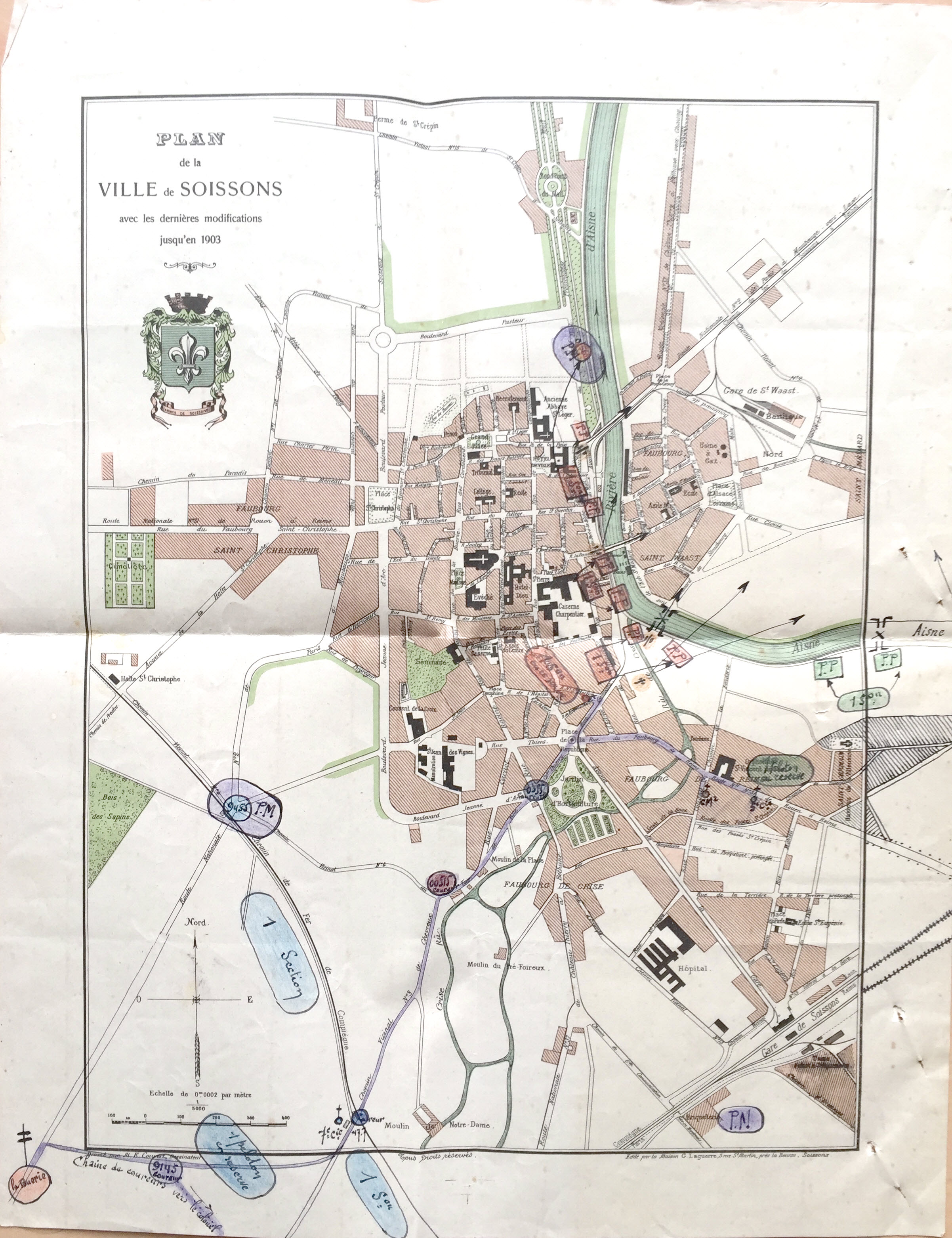
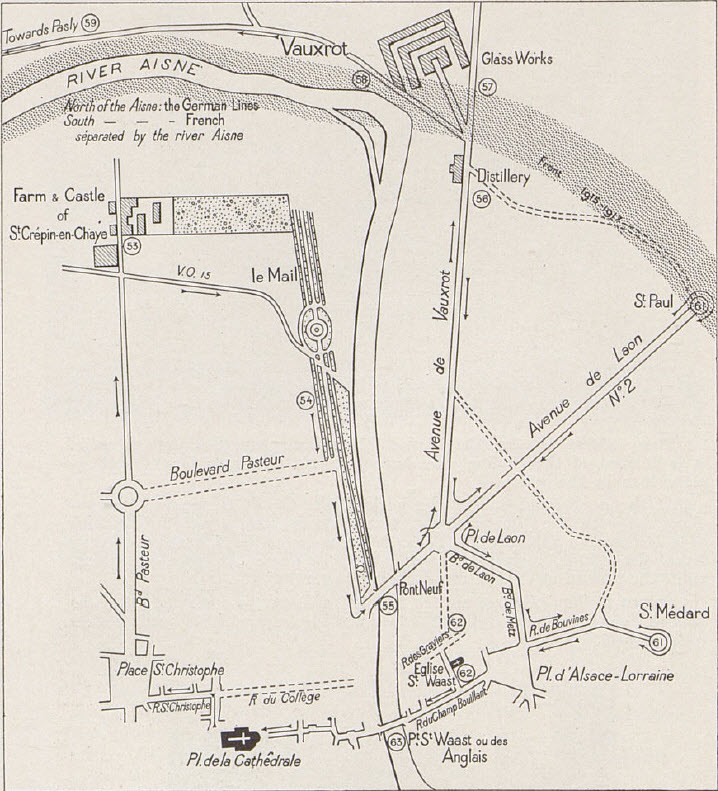
Left: Map of Soissons showing the regiment's positions at the end of August 1918. (source: JMO 69 DI). Right: Map of the northern environs of Soissons, including Le Mail public gardens (source: Michelin Illustrated Guides to the Battlefields: Soissons. 1919.)
Assault Order: Jackets (without greatcoats), no pack or blanket, tent-canvas in a roll, 2 days rations on the man, 200 cartridges.
Liaisons: With the 72 DI via mixed detachments from a company and a half-company of machine-guns under the orders of an officer of the 151. The 3 Bat. will provide as a result one section and one mixed section. Liaison also via posts established at Vauxrot and the Crouy station. With the 5 DI: the 69 DI movement will be flanked by the machine-gun fire provided by the 74 RI from the south bank. The PC of the division will be at the Vignolle cavern, the PC of the regiment will be on Côte 94.
The following are brevets to sous-lieutenants and transfers are made: Aspirant Gouthiere to 2 MG Co., Aspirant Foumir to 1 MG Co., Aspirant Haneuse [sp?] to 9 Co., Adjdant Pugnaire to 1 Co. Losses on 26 August include 2 killed and 5 wounded.
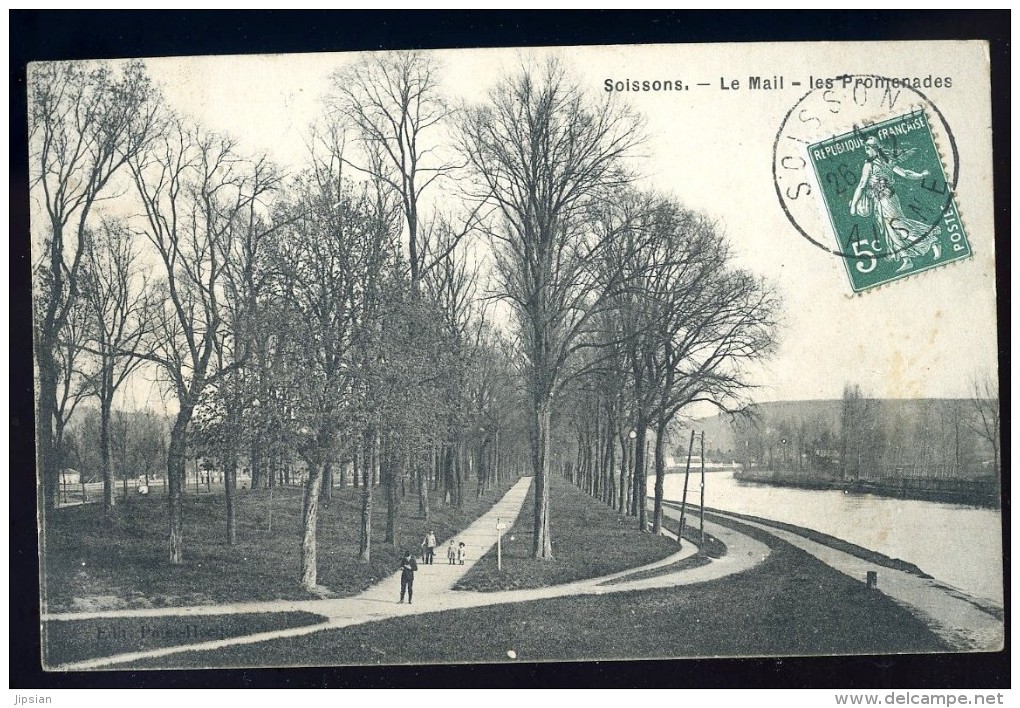

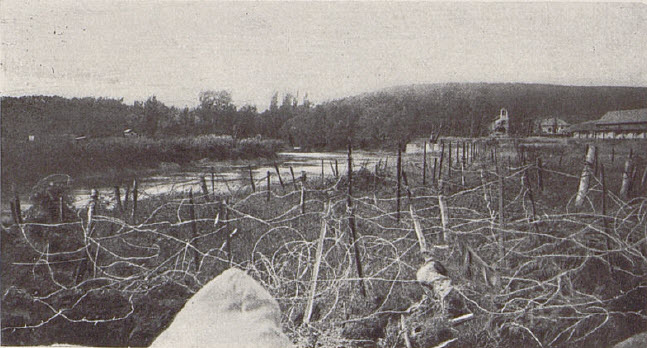
Left: the promenade of Le Mail before the war. Center: the promenade during the war. Right: Right bank of the Aisne with Vauxrot glass-works on the right (a German MG was located below the crane visible to the left of the chapel).
27 August: The attack is set for 0800 hrs on 28 August 1918. The 3 Bat. takes up the trenches on the Aisne near Bois Roger and Saint Crepin-en-Chaye. The battalion receives orders to cross the Ainse at Pommiers in order to the Bois Roger as its departure base. The day is spent in preparation for the attack and getting in place. The 1 Bat. inserts itself during the night between the 3 and 2 Bats., facing its two crossing points. The Germans have reinforced their artillery, they bombard the rear areas especially la Buerie and the 14 Maisons. Losses on 27 August include 2 killed and 4 wounded. Sous-Liet. Lambert (10 Co.) is evacuated due to illness.
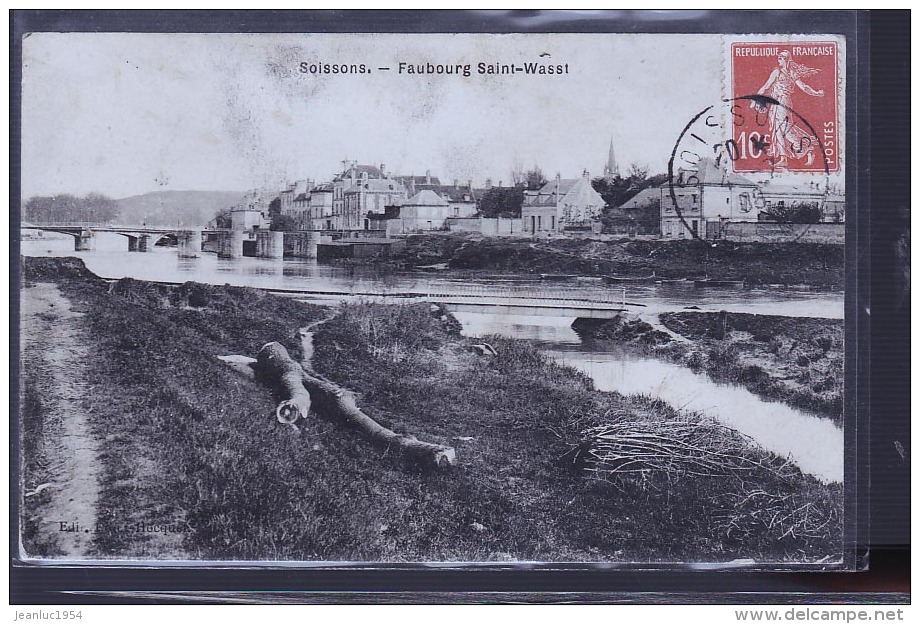
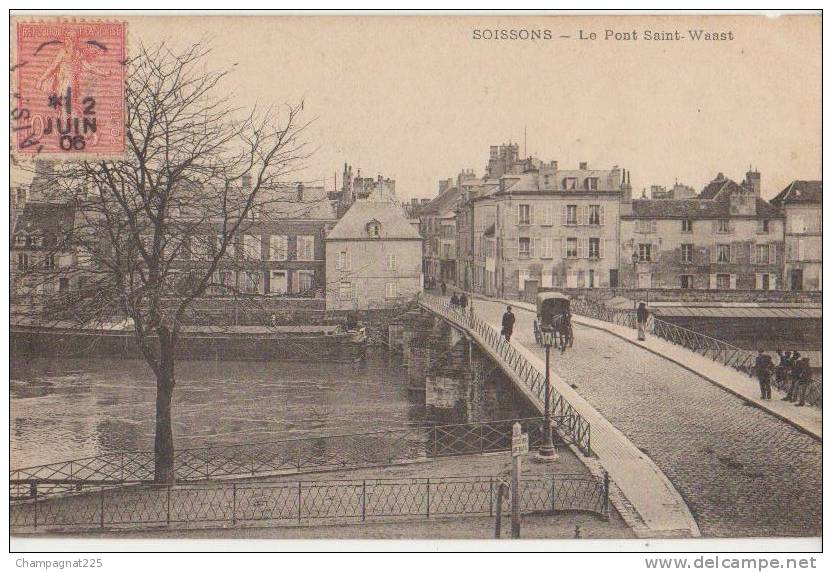
The faubourg Saint Waast and the Aisne River before the war.
28 August: At 0400 hrs, Lieut.-Colonel Perchenet transports his PC to Côte 94. At 0500 hrs, 3 Bat. is in place, the crossing of the Aisne by 3 Bat. is carried out at Pommiers with 11 Co. in the lead. The mission of 11 Co. is to put itself in liaison with the 418 RI at Bois Roger and move forward to the overwhelm Vauxrot from the south. The 10 Co. overwhelms the village from the north and the 9 Co. is in reserve. The 2 Bat. makes way in Soissons for the 1 Bat. in the night of 27-28 August to allow it to face Saint Waast. The 2 Bat. regroups by company in the faubourg Reims up to the railway. It must arrange itself in the two crossing points, one close to the water station northwest of Côte 67, the other for 5 Co. The 7 Co. in reserve will follow behind.
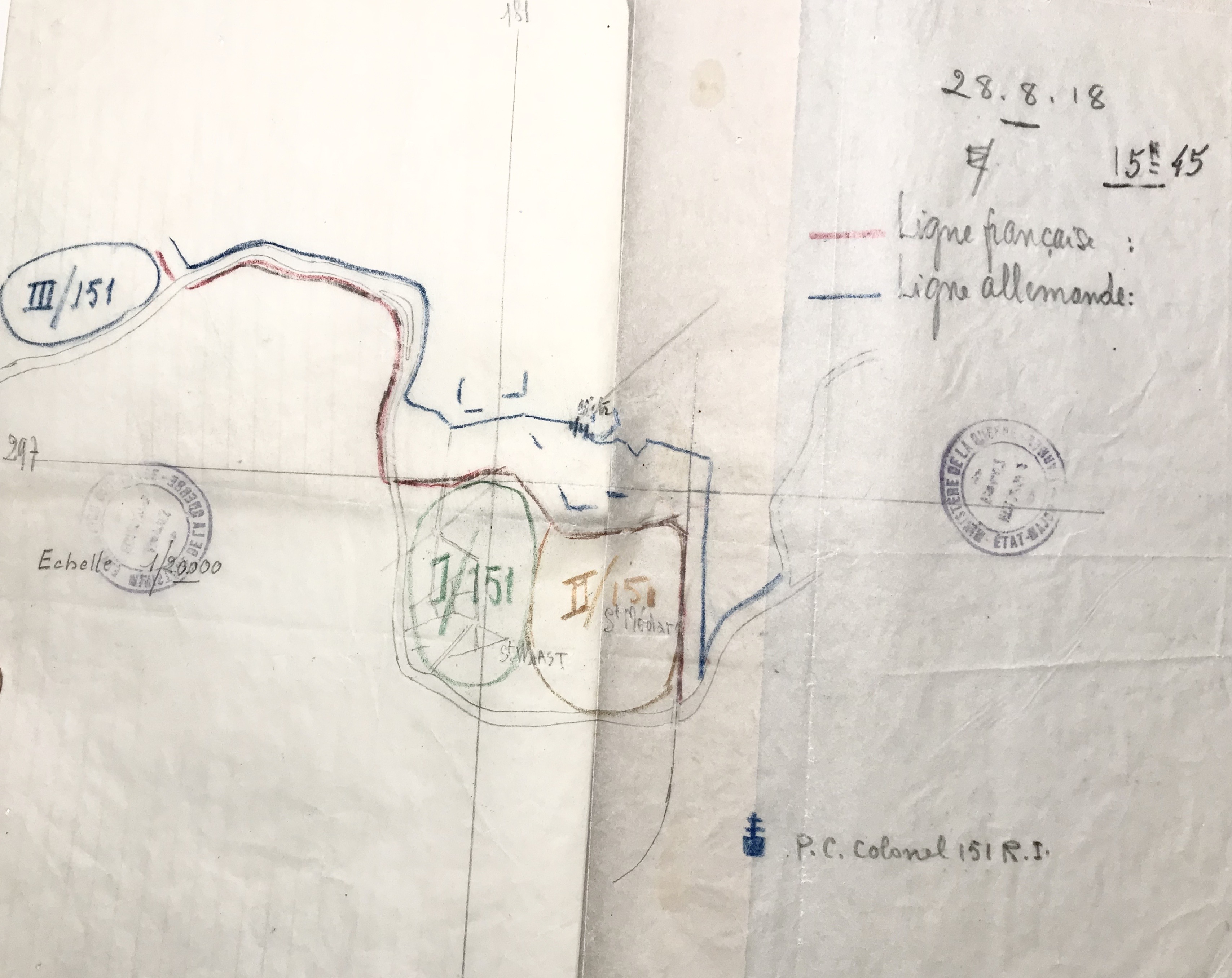

Left: sketch of the disposition of the 151 at end of day on 28 August. Right: Sketch made by Capt. Bourgoin of the 151 RI successive positions during the fighting at Soissons.
The 1 Bat. also has two crossing points, the 3 Co. at Le Mail gardens which must immediately follow the 1 Co., the 2 Co. opposite Saint Waast. During the artillery preparation at 0730 hrs a munitions depot blows up south of Crouy. The distillery below the village is on fire. L'Heure 'H' for 3 Bat. is set for 0700 hrs. At 0700 hrs the 11 Co. progresses to about 300 meters beyond the destroyed bridge at Bois Roger and then is immediately immobilized by storms of machine-gun and artillery fire coming from Vauxrot and the crests of Côte 129. Any advance is made impossible. The men are forced to jump into the river up to their waists to take shelter from the enemy fire.
The 10 Co. receives orders to attempt to make progress by an element progressing through the trench. It is able to make an infiltration by several hundred meters. Capt. Bertrais is wounded in leading his men. This attempt having not succeeded in the evening, 9 Co. makes its own attempt make an infiltration. Capt. Thomas commanding 3 Bat. is wounded while leading his men and Capt. Sehnarsfeld takes command of the battalion. The 9 Co. manages to advance but is soon forced to stop its movement.
For the 1 and 2 Bats. l'Heure 'H' is set for 0800 hrs. At this time, the engineers (who'd already constructed footbridges to be used by the men in the crossing, dash down to the river carrying the rafts in their hands but are very quickly cut down by machine-gun fire. This is combined with an intense artillery barrage on the Aisne, making any movement very difficult. With the engineers wiped out, volunteers from the 1 Bat. stepped forward to finish the job. Stripping off their coats, shirts, and any unnecessary equipment, the men rushed down to the river. Bullets ripped up the water all around them. Despite suffering many losses, volunteers managed to make it to the opposite bank and and (presumably) establish lines across the river to allow for the troops to be ferried across by their comrades. Countless acts of bravery went unseen or unrecorded, though a few were captured. There was Corporal Mérel (1 MG Company) who, at great personal risk to himself, set up his machine gun on the river embankment in a dangerously exposed position so as to better direct fire against the enemy guns and to draw their fire away from his comrades crossing on the rafts. At the same time, Corporal Le Guével and Soldat Coppier (or Coppin?) of the 2 Co. jumped on a boat to cross over the river, along with a third man who was soon wounded. Despite the shells striking down nearby and bullets zipping past, the two managed to make it to the other side and take cover in a shell hole. There, the two men fixed bayonets and made a dash on an enemy machine gun that had temporarily brought the regiment’s movement to a halt. A few moments later, they emerged with the German gunners as their prisoners. Soon the entire 2 Co., followed by 1 Bat., was across the river and fighting through the streets of Saint-Waast before pressing on to Saint-Médard.
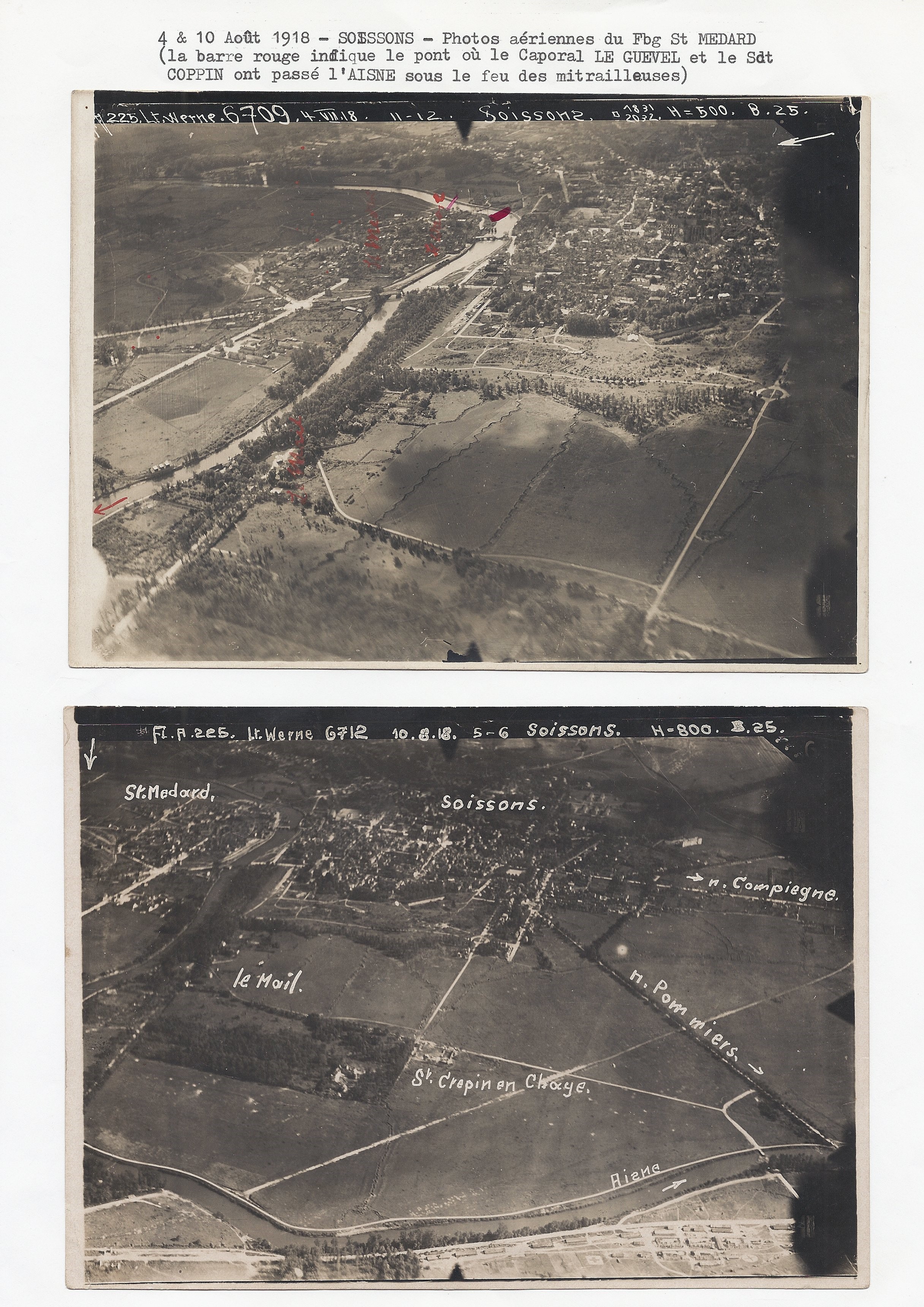
Photographs of Soissons and surroundings, 4 Aug. 1918. This view is looking south to Soissons (right), with Le Mail in the foreground, Saint-Médard (left). As the top caption notes, the red bar indicates where Cpl. Guevel and Sdt. Coppin crossed the river.
The situation for 2 Bat., close to the railroad bridge, was much worse. At this spot the crossing is also taken by a crossfire of machine-guns placed on the edges of the river and which were not hit by the trench artillery. All the efforts of the engineers to make the crossing of the river by rafts is checked by artillery and machine-gun fire from the right banks of the Aisne. The sappers try in vain to set out the rafts which flounder, the men in the teams are killed and wounded one after the other. Only 5 Co., with a section of the 2 MG Co. passing over over in groups of four manages to make it to the other side. In light of the situation, the battalion leader of 2 Bat. decides to call off any further efforts for crossing the river here. Lieut.-Colonel Perchenet subsequently orders the 6 Co, 7 Co., and 2 MG Co. to shift over and attempt to cross the river, behind the 1 Bat. which has fortunately with the help of the engineers managed to obtain a quicker point of passage. Starting at 1300 hrs, the 7 Co. then 6 Co. crosses the river on rafts to the northwest of Saint Waast.
From 1200 to 1500 hrs, the fighting is tough, with frequent counter-attacks. The units are advance only foot-by-foot using the grenade, though they mange to take Tranchee Beeker-Corderie and progress towards Tranchee Belvedere. After superhuman efforts, the engineers attempt again to construct a footbridge. At 1600 hrs there are strong counter-attacks against the train station and against 6 Co., which are repulsed. The 2 Co. tries to assault seven times the Tranchee de la Ballastiere. The 3 Co. pushes the enemy back and corrects the small gains the enemy had made. At the end of the day the enemy counter-fire increases, seemingly heralding a general counter-attack. With the help of requested artillery fire, the enemy counter-attack is stopped.
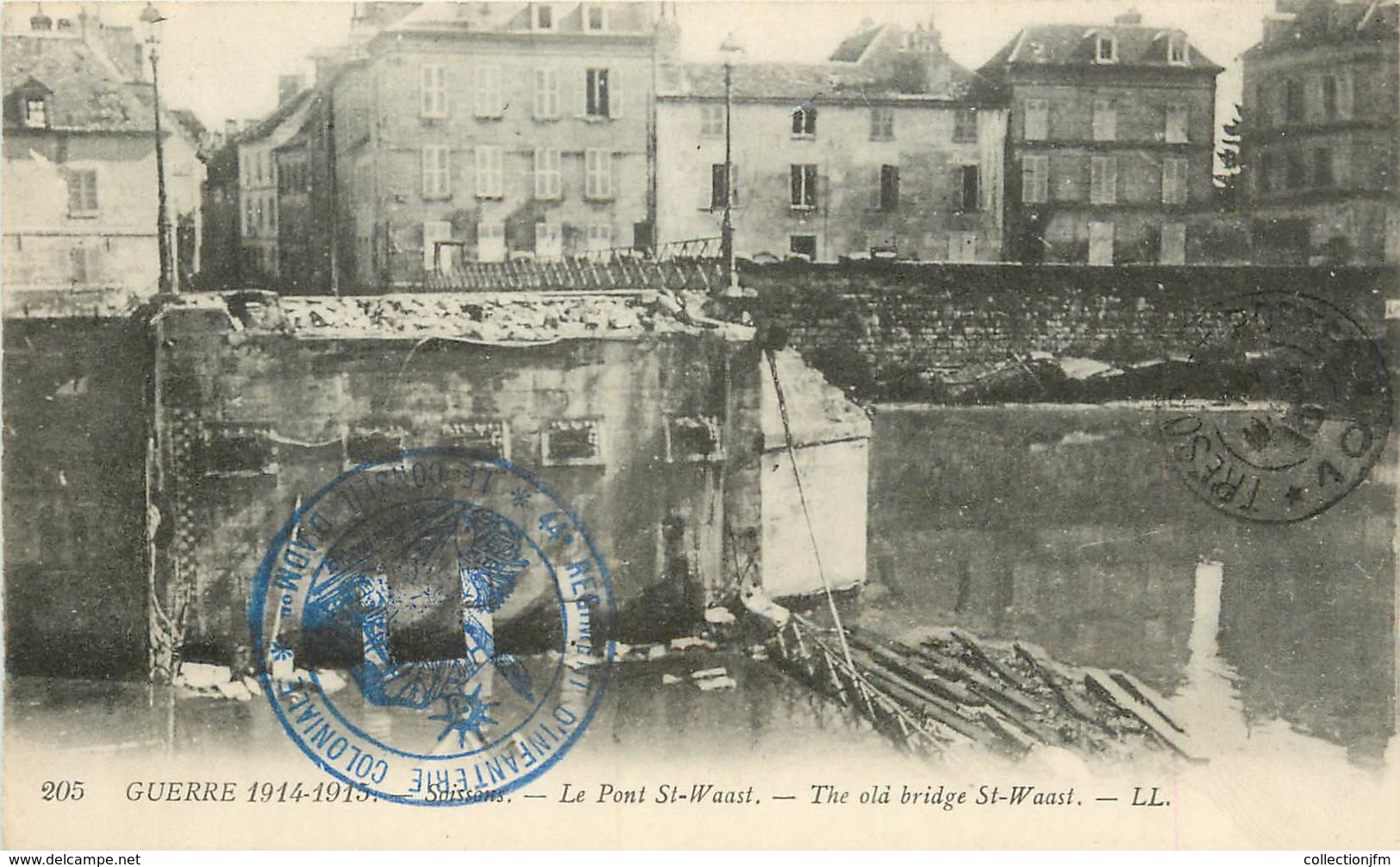
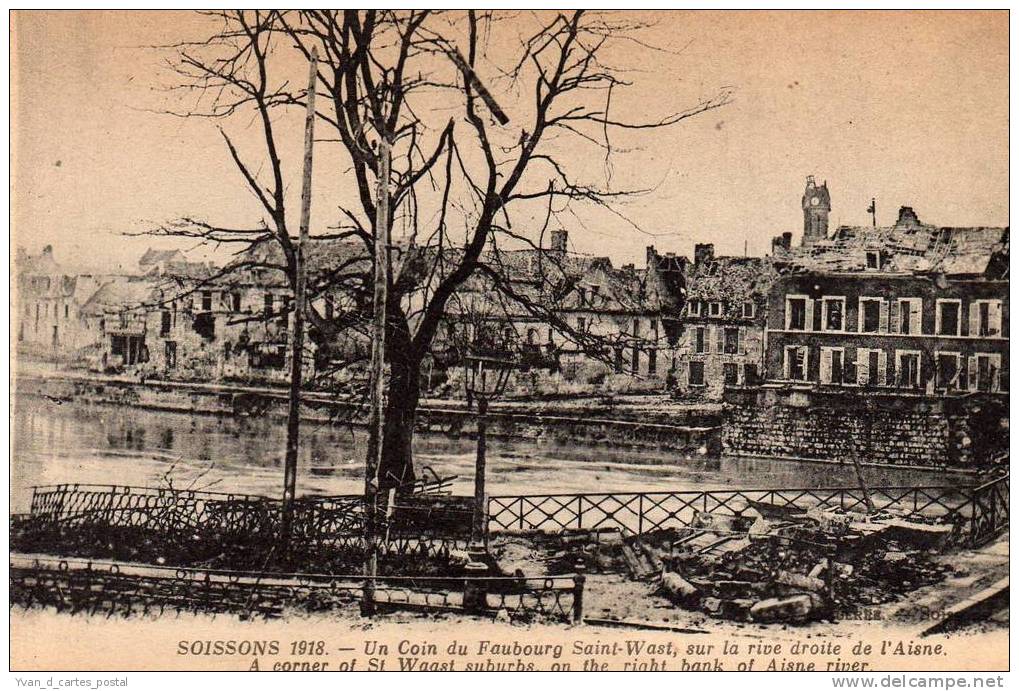
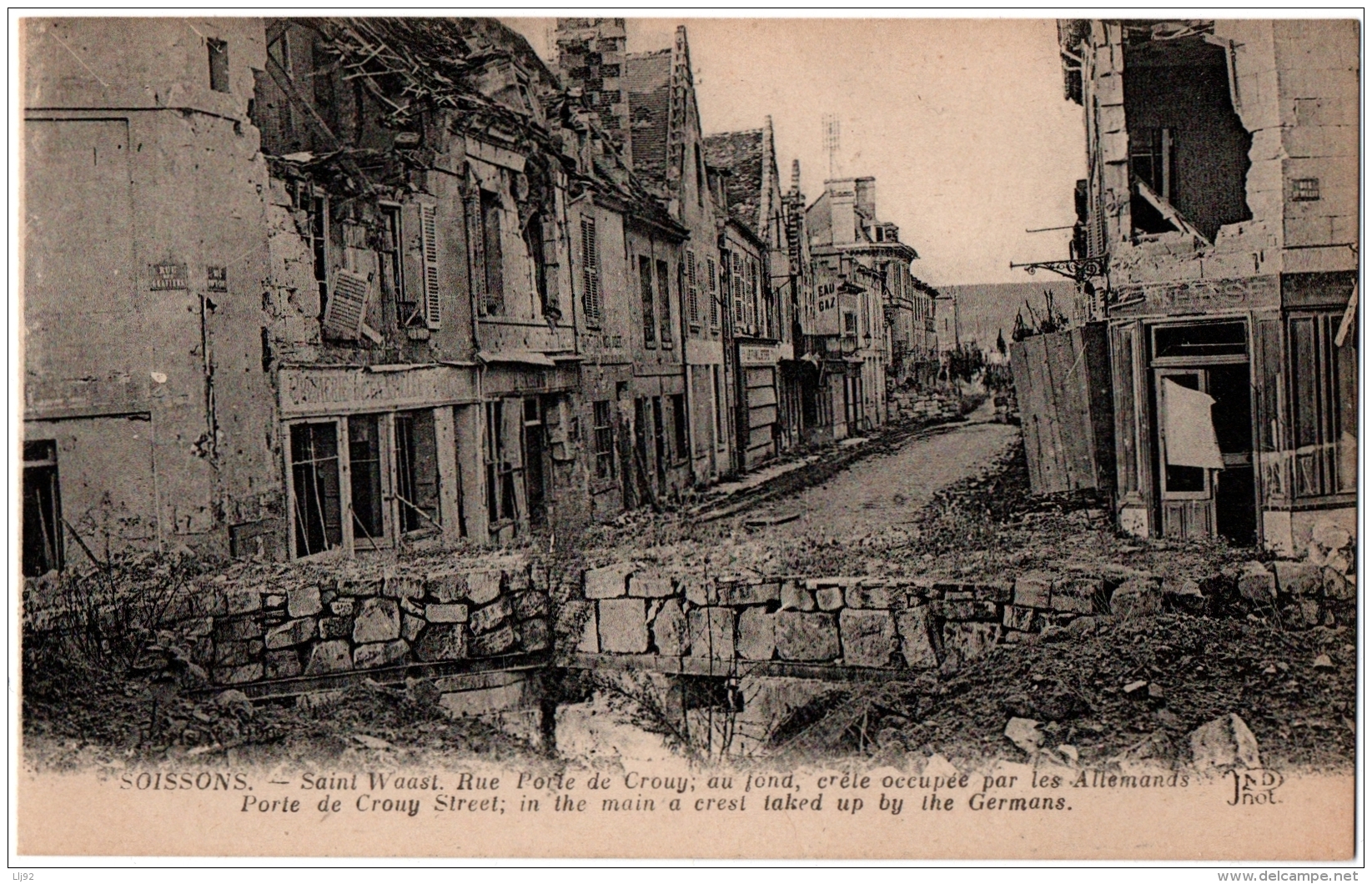
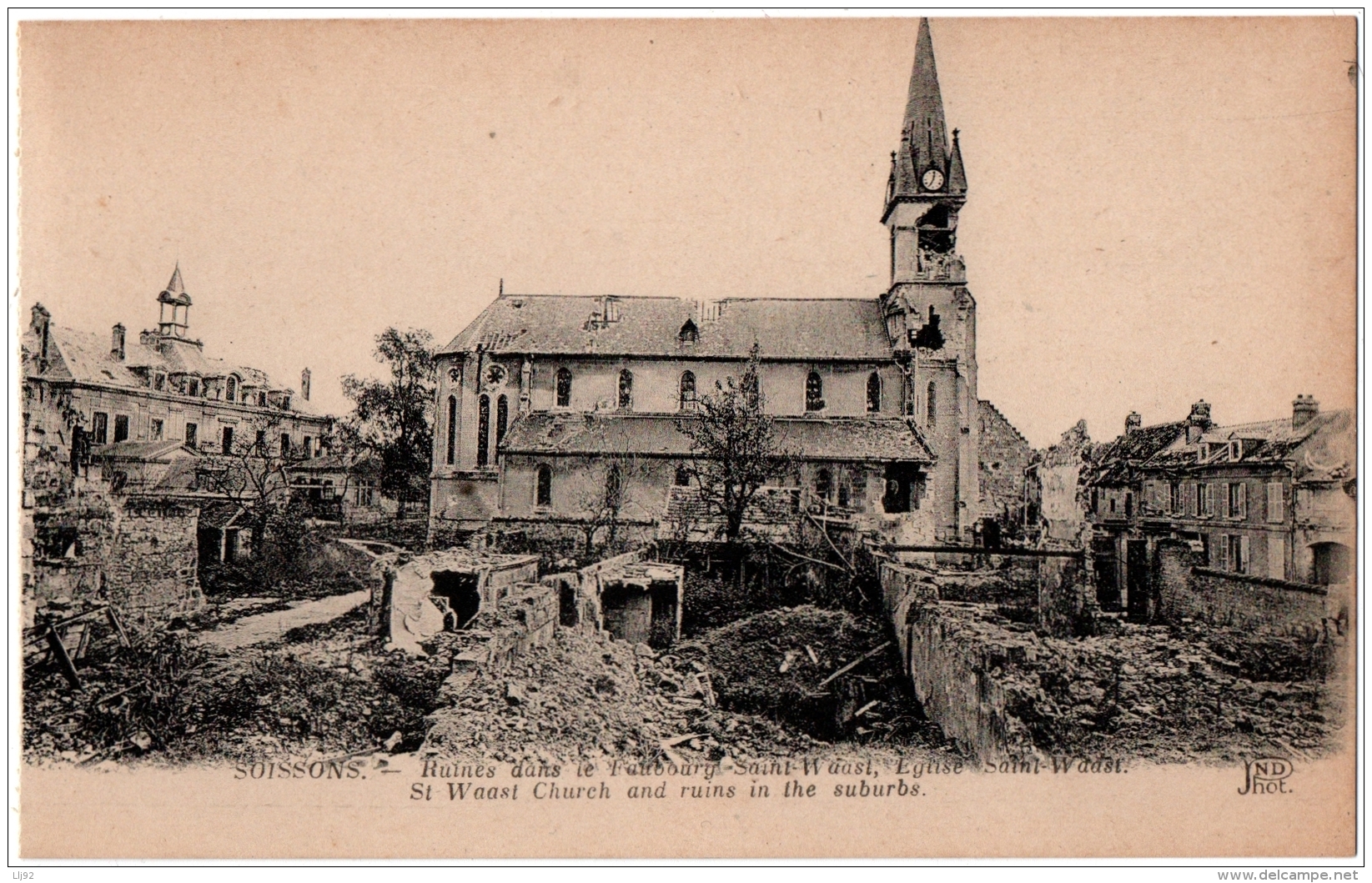
The faubourg Saint Waast in 1918.
At 1710 hrs all the units of the regiment have been engaged. A battalion of the 162 RI is put at the disposition of Lieut.-Colonel Perchenet, who orders that a company move up to the Aisne and take shelter with the other units in Soissons, ready to cross the river immediately and to back up the companies of the 151 should they need to cross back to the south bank. At 1730 hrs the situation for the 1 and 2 Bats. is as follows: they hold the faubourg Saint Waast and Saint Medard, the right along the railway facing east. At 1800 hrs division orders the 1 Bat/151 RI and 1 Bat/162 RI to attack at 1900 hrs against the Vauxrot distillery. The battalion from the 162 RI receives orders to fully cross over the Aisne. In the event it takes the units awhile to get in place and is only begun at 2000 hrs but only the 2 Co. of the 151 RI is able to advance. The 162 RI is unable to set off and is pulled back under the protection of companies of the 151 and moves into support.
To the right of 2 Bat., the 5 RI carries out small operation in the night on the Tranchée du Canal but fails to cross the water. In the night the battalions of the 151 are ordered to regroup. The 3 Bat. was also facing difficulties, as it came under heavy and precise machine-gun fire form enemy positions on Côte 129. The companies are forced to lay prone and are only able to advance in small groups from street to street and building to building, crawling their way to Vauxrot. Despite the heavy losses, the crossing of the Aisne is forced by two battalions in front of Saint Waast and Saint Médard. The artillery preparation expected to have strongly shaken the enemy defense under the blows of the trench artillery would be reduced to an impotent position has only partially been achieved and the damage observed seems to be rather insignificant. Moreover, it's been observed that the trench artillery's range was too long and that the banks of the river where the enemy machine guns were in place were not destroyed. The engineer sappers are the admiration of the 151 and it is to their greatest merit that they managed to secure the crossing of the river for the infantry.
The following transfers are made: Capt. Benoit takes command of 3 Bat., replacing the wounded Capt. Thomas. Sous-Lieut. Fraissinet is transferred from 11 Co. to 9 Co. to assume command. Sous-Lieut. Richard takes command of 10 Co. Sous-Lieut. Roger takes command of 3 MG Co. Sous-Lieut. Gastin takes command of 2 Co. Losses for the regiment on 28 August include 25 killed, 100 wounded and 1 missing. Among the casualties are Capt. Thomas (wounded), Capt. Edmond, Lieut. Noel, Sous-Lieut. Beffaras, Sous-Lieut. Boboss, and Lieut. Hugon.
29 August: In the night of 28-29 August, orders arrive to retake the attack at 0525 hrs, supported by a rolling barrage set to begin at 0500 hrs. The objectives are as follows: 1 Bat/151 RI and 1 Bat/162 RI under the orders of Cmdt. Caisez are assigned the Vauxrot distillery and Saint Paul brickworks. 2 Bat/151 RI along the railway, Tranchée du Rû, Tranchée de la Sablière. Their objectives remain the same. The objectives of the regiment of will vary depending on the progression of the division on the left. The disposition of the attack is as follows:
The 1 Bat/162 RI having two companies in line and one in support between the Aisne and the part of the line west of the orchards of Saint Médard. The 2 Bat/151 RI along the railway leading off to the west up to the line marcked by the dirt road leading to the north end of the orchards of Saint Médard up to the western part of Tranchée du Ru. The liaison between 1 Bat/162 RI and 2 Bat/151 RI will be assured by 2 Co. The 1 and 3 Bats. as well as 1 MG Co. will reform behind the attack elements and follow their progression. The 3 Bat/151 RI still under the orders of 72 DI, which is to attack Vauxrot.
At 0525 hrs, the attack begins. On the right 2 Bat. with it first line companies are pinned to the ground 80 meters from Tranchée du Belvedere by the sweeping enemy machine-gun fire and is forced to take cover. The 1 Bat/162 RI takes the Vauxrot distillery and 2 Co. approaches the gravel pits. The enemy reinforces with fresh troops and especially machine guns. The 3 Bat. which has begun its advance at 0200 hrs has been stopped, after a short advance, by a long and heavy storm of machine-gun fire. The advance is retaken up to the little woods southeast of Vauxrot. And lement of 10 Co. preceding the battalion moves along the banks of the Aisne but is stopped by a machine gun which checks all movement. The companies start infiltrate the enemy positions along the Aisne as the enemy force begins to break. Yet multiple machine guns open fire and once again force the elements of the 151 to take cover.
The most serious obstacles for the 2 Bat.'s advance is presented by a machine gun established on the left flanks in the orchards to the north of the enclosure of Saint Médard. The 7 Co. attempts to approach utilizing its weaponry accompanying it. Little by little, at the cost of heavy losses the sections of 7 Co. engaged the machine-gun nest and assault it with grenades. To the east of the railways line the 6 Co. and section from 7 Co. resist and repulse enemy counter-attacks on their right. Around 1400 hrs elements of the 5 RI crosses the Aisne over the railway bridge behind the 2 Bat/151 RI. The 2 Bat/151 RI is stopped at all points in front of Tranchée du Belvedere and is unable to move. At 1710 hrs, 1 Bat/162 RI resume the attack in order to take the assigned objective.
At 1710 hrs, 1 Bat/162 RI resume the attack in order to take the assigned objective: Tranchée de la Briqueterie up to the Aisne, then to the Maubeuge road. It takes these and at the end of the day the Vauxrot distillery grounds and brickworks are held up to the Vauxrot - Saint Paul road. From the eastern grounds of the brickworks the French line passes to the west of the point 1272 and then links up with the old front via the Tranchée de la Corderie, Tranchée de la Ballastière and Belvedere. Sous-Lieut. Simomnnet transfers from 6 to 11 Co. to take command. Losses for the regiment on 29 August include 22 killed and 96 wounded (incl. Capt. Bertrais and Capt. Schwarzfeld, and Sous-Liet. Hanesse).

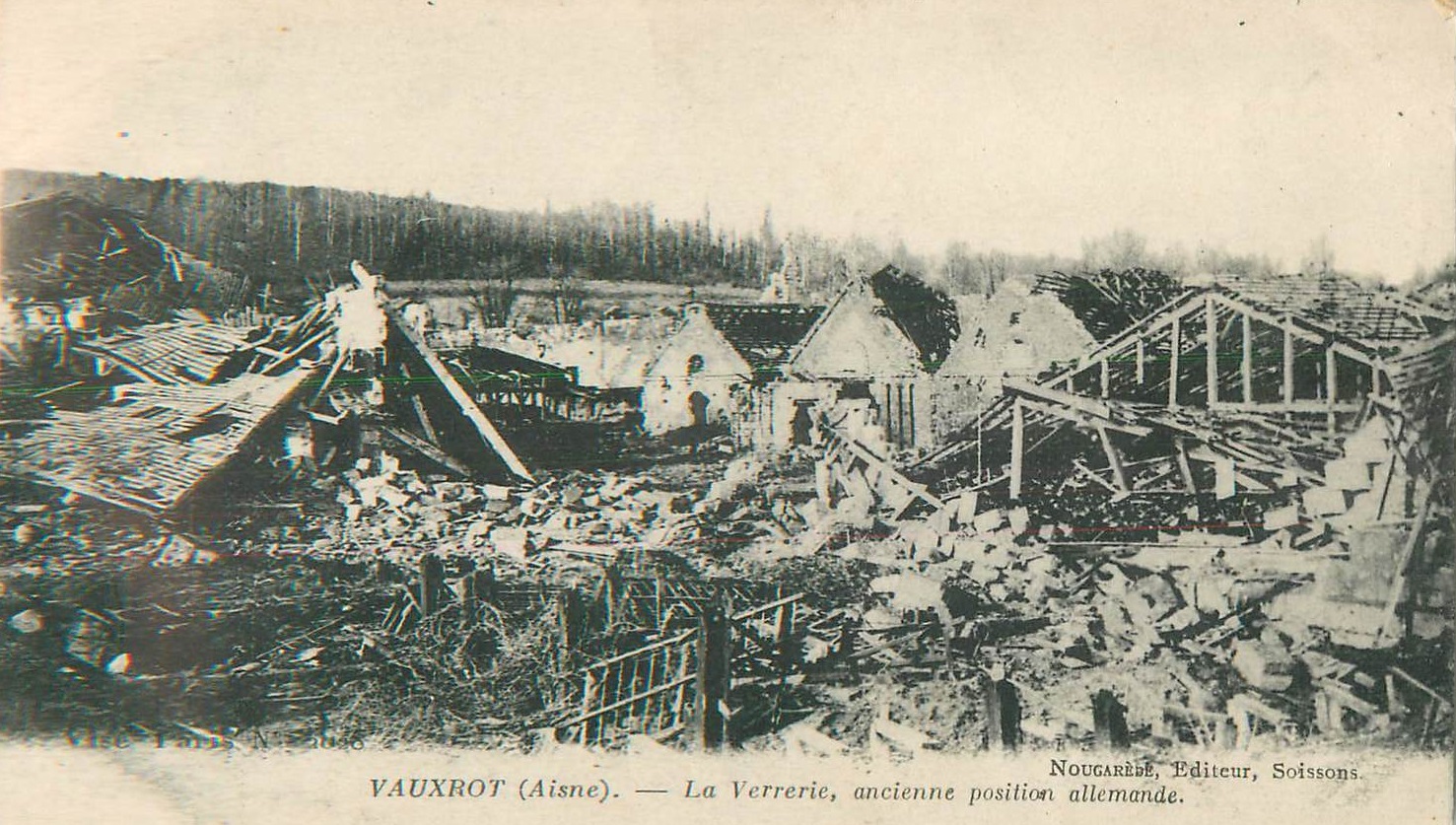
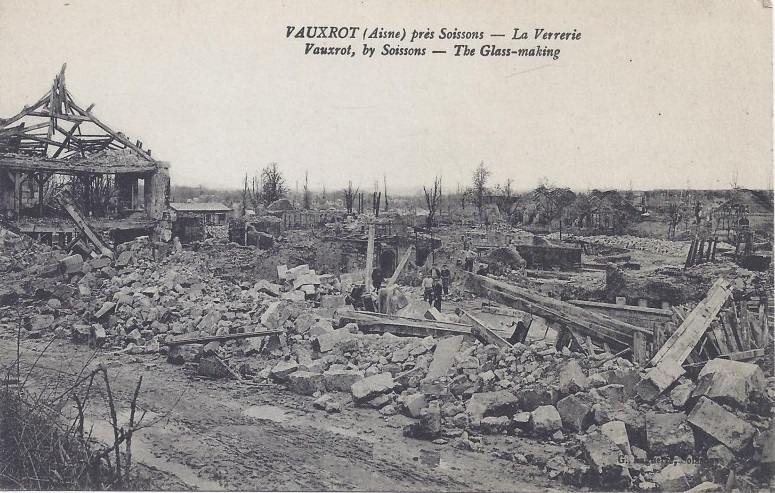
The Vauxrot glass-works before and after the war.
30 August: An attack is planned on the Vauxrot glass-works facility at 1430 hrs. Like the Vaurot distillery, it was a veritable stronghold. Between the buildings of the works, now completely ruined by the incessant bombardments, were countless passages and trenches of reinforced concrete, observation posts, blockhouses, concrete machine-gun positions and deep dug-outs. At 1100 hrs the 3 Bat. reports it has reached the southwest edges of Vauxrot and is continuing its progression along the Aisne. At the same time, the enemy is observed to be falling back. Reconnaissance parties are immediately pushed forward and at 1245 hrs the 5 and 6 Cos. Occupy the trenches between the Aisne and the Maubeuge road (i.e., the National Road No. 2) without facing resistance, while 7 Co. holds Tranchée de la Sabliere. The 1 Co. penetrates the Vauxrot glass-works facility. At noon, 2 Co. passes la Ballastière and moves to Saint Paul and then the railway. On its left, 3 Co. moves up alongside it. The 1 Co. moves up in support to Tranchée du Rû. Lieut.-Colonel Perchenet moves his PC up to Saint Waast.
The reformed 1 Bat/162 RI is pushed up to Vauxrot and Ouvrage du Rhin to protect the 151’s movement and relieves 3 Bat/151 RI at Vauxrot at 1335 hrs. The 3 Bat. returns back under the command of the 151 and is then ordered to move up to Saint Paul in support of the regiment. At 1535 hrs the objective of the regiment is in line of the northwest elbow of the Aisne (to the south of Crouy), Ferme Clémencin. The 2 Bat. is between the river and the Maubeuge road and 1 Bat. between the Maubeuge road and the farm. Starting at 1600 hrs 1 Bat. is on the edges of Crouy, a section in the village itself, patrols moving through the wells south of the Montagne Neuve and the Bois du Signal, which are still occupied by the enemy. Apart from a rather strong German artillery response, the advance is made without engaging with the infantry. In the night the regiments patrols are fired upon from the trenches located at the base if the plateau northeast of Crouy. Sdt. Duhamel (1 MG Co.) is awarded the Médaille Militaire. Lieut. Diévart is transferred from 1 MG Co. to 3 MG Co. to take command. Losses include 11 killed and 29 wounded.
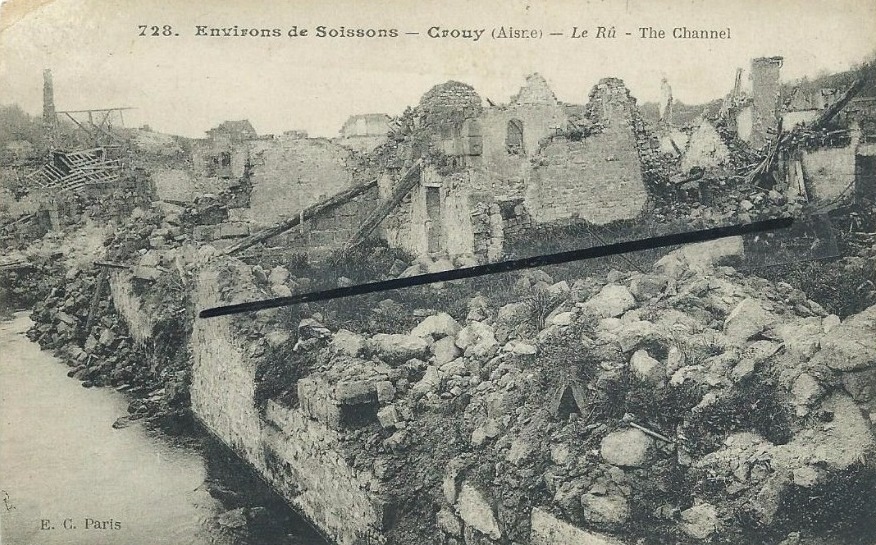
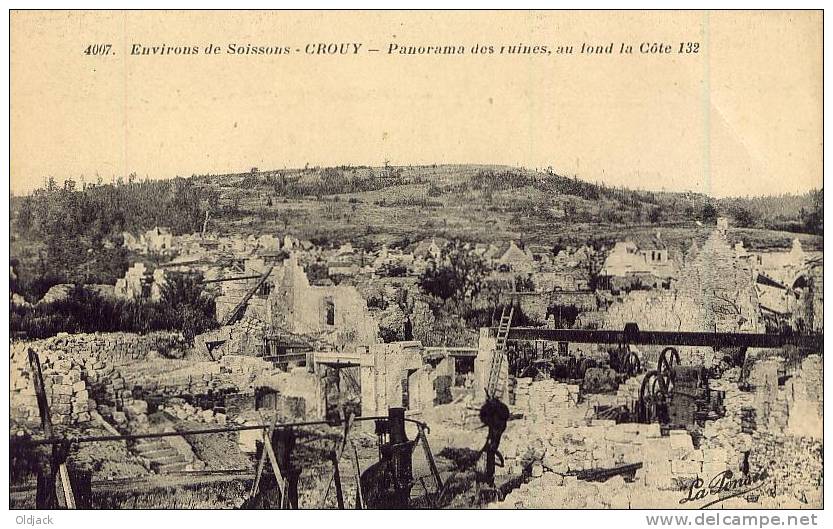
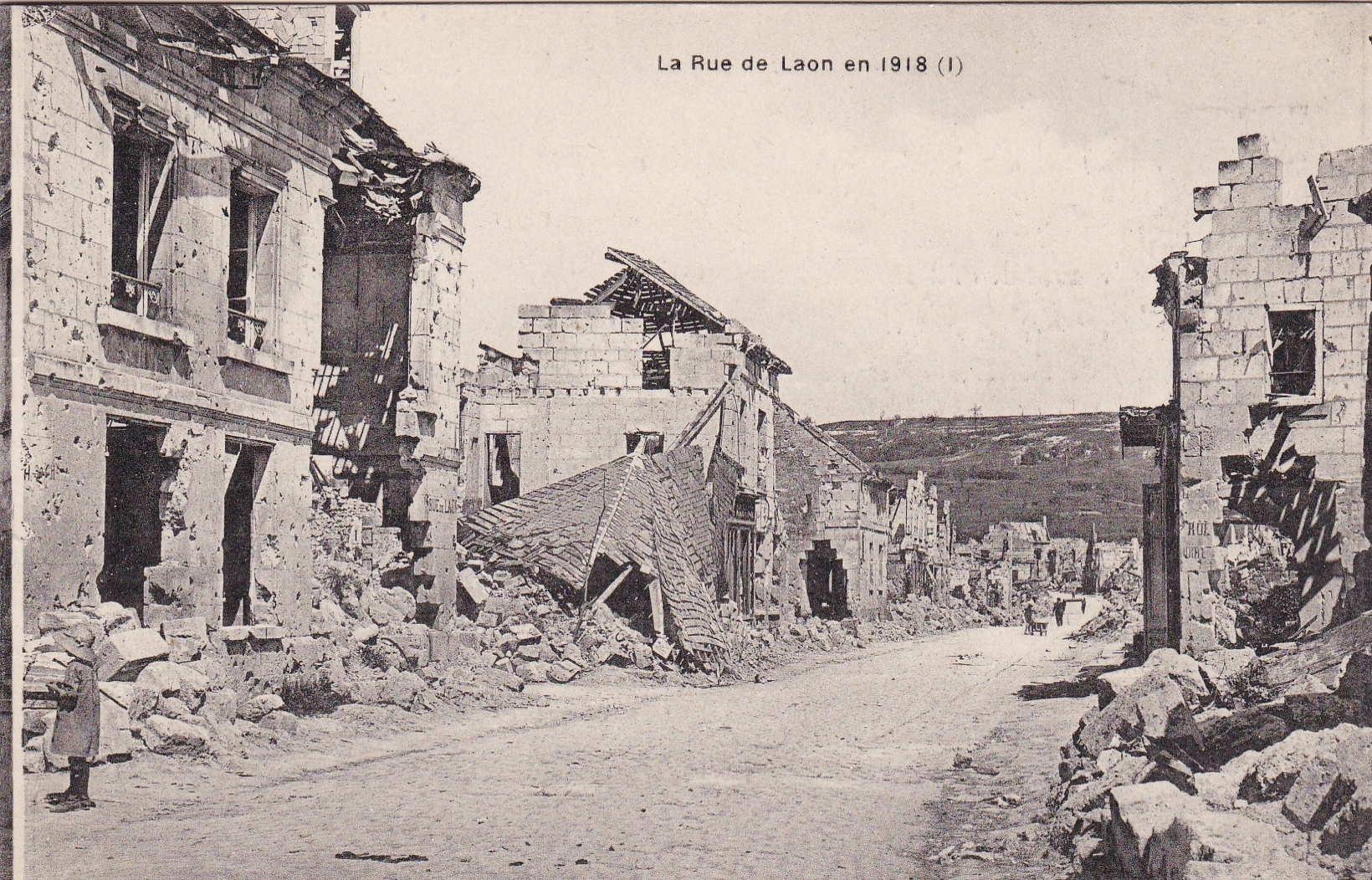

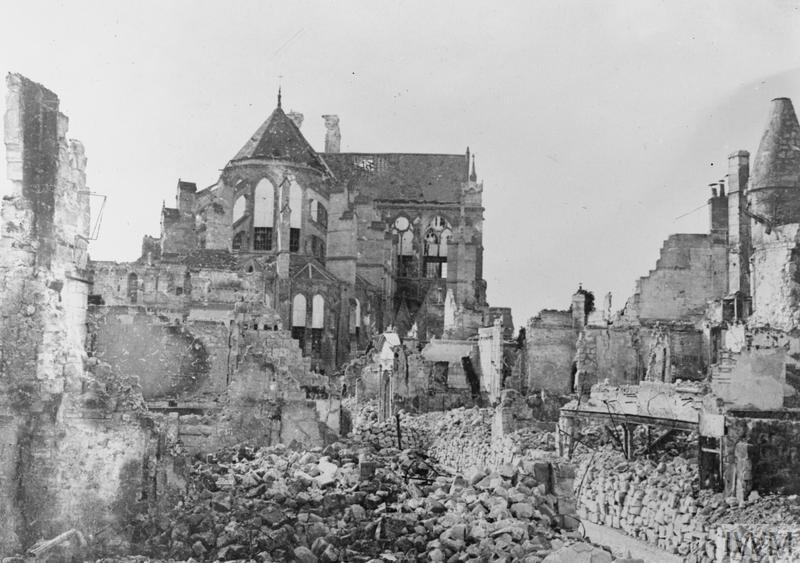
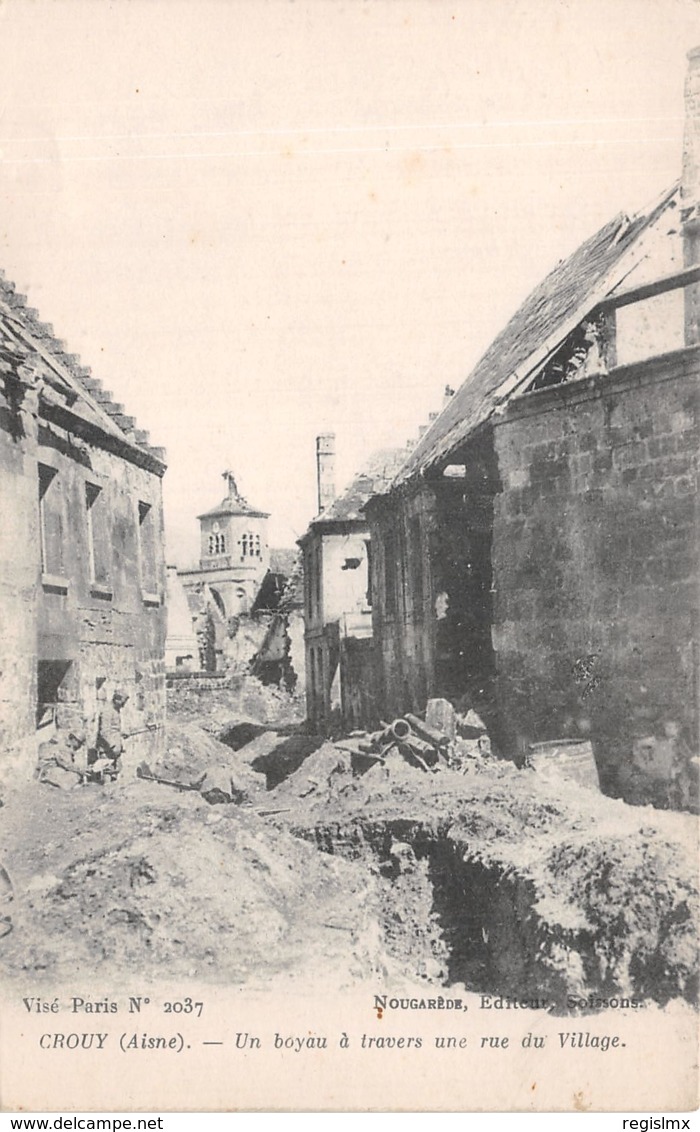
Crouy in 1918 after the fighting. The hill looming in the background in certain images is Côte 132.
31 August: The regiment is to recommence its movement at 0500 hrs. Artillery support will be provided upon request by battalion leaders. Its axis of movement is parallel to the Maubeuge road. It’s objective is the line marked by the Ravin des Zouaves on the left, point 4494, the node of trenches in 4688, the line descending to the south and heading to the edge of the northwest Bucy-le-Long ravine. The 2 Bat. is on the right, 1 Bat. on the left, 3 Bat. in support behind the 1 Bat. The limit between the battalions are the Crouy-ravine cemetery east of Crouy in entirety to the right of the right battalion. For security on the right, the 2 Bat. should look to make liaison with the 5 RI near the Crouy distillery and maintain the flank as this regiment will not be level with the 151. On the left, as the situation with the 41 DI is not known, the 1 Bat. and 3 Bat. must particularly watch their left flank. The 2 Bat. on the right and 1 Bat. on the left are echeloned in depth. The 3 Bat. has a company on the northwest borders of Crouy, a company near 35 – 87 to the point of the plateau, its third company at the Crouy cemetery. Two sections of Artillerie Speciale (i.e., tanks) from the 320 and 323 Cos. (503e RAS) are put at the disposition of the regiment.
At 0500 hrs the attack is launched. The companies in the first line quickly take ground. The 2 Co. contours the village from the east, the 3 Co. from the west. The 1 Co. protects the open left flank, facing the woods of the glacis. The 6 and 7 Cos. Press too far to the right and pass to the south of the Crouy cemetery. They reach the trench parallel to Tranchée Lutzow (east and southeast of the cemetery). The 5 Co. marches to the cemetery and comes naturally to fill the hole existing between the left of 2 Bat. and the right of 1 Bat. The fighting is extremely hard, the enemy offering a strong resistance with many machine-guns, artillery and mortar fire. The village of Crouy, which had been in good state in the morning, no longer exists by the evening, and at each moment its appearance changes. Two assault tanks are destroyed by artillery, the others have turned back behind the railway embankment. All day long the companies push the attack, which is the only way to hide the weakness of the regiment’s effectives from the enemy.
At each halt, the machine guns of the units are pushed in front of the line to make contact with the enemy and set up into position. It’s the machine guns that hold the front lines during this period, as the foot-soldiers are reformed behind and then sent forward again into the assault. The 2 Co. to the northeast of the cemetery scales up the midway point of the hill and hangs onto its position. The 3 Co. is northeast of Crouy. French and Germans units are completely entangled together. The Germans, more numerous in number. The fighting is savage, the combatants using grenades and bayonets. The enemy falls back, counter-attacks, and is then pushed back again further.
The 1 Co. is to the west of the railway. The enemy opens a harassing fire coming from the woods of the glacis, particularly from a trench to the south. This trench is then taken, the company holding on against a strong enemy counter-attack broken up by the fire of a machine-gun brought into the position. The Crouy cemetery is defended to the east by a platoon of the 5 Co., which will hold on against an enemy at grenades distance away, facing 5 enemy machine guns. At 0950 hrs, the rest of 5 Co. on the railway is ordered to advance to the Crouy cemetery to form a defensive hook. The company resists blows from multiple counter-attacks, each of which is repulsed. The 6 and 7 Cos. are between the cemetery and the distillery and are isolated by a bombardment of incredible violence. The 3 Bat. suffers all day long under a strong bombardment of high-explosives and poison gas.
Every man present sticks to his shell-hole under an avalanche of shells and incessant barrages of machine-gun fire. Despite the low number of effectives, the regiment still manages to advance despite the superior forces of the enemy, in the face of incredible machine-gun and artillery fire rarely seen before. In Crouy, the fighting moves from street to street and cellar to cellar. At night, all of the regiment’s objectives had been achieved and the 151 is at last relieved. The regiment had advanced over 3 km, earning yet another citation in the Orders of the Army and fifth battle honour (Soissons) for its regimental colors:
During the course of very tough, sustained fighting from 28–31 August 1918, under the command of Lieutenant Colonel Perchenet, [the 151 IR] had forded in quick action a river in the crossing of a town, despite the organized defence of the north bank and the presence of numerous machine-gun nests placed in the houses.During the night, the 1 Bat. is relieved by a battalion of the 162 RI and the 2 Bat. by a battalion of the 129 RI. Lieut. Pfifferling takes command of 3 Co. Lieut-Colonel Perchenet’s PC moves to Saint Paul. Losses on 31 August include 28 killed, 84 wounded (incl. Capt. Cormier, Sous-Lieut. Delmon), and 61 missing. In total, the Battle of Soissons cost the 151 about 890 killed or wounded.Has conquered, foot-by-foot and house-by-house, the suburbs north of the town, capturing it through three days of bloody fighting, from the point of departure to the subsequent attacks and holding on to it despite five enemy counter-attacks.
1-7 September: After being relieved, the regiment occupies the following emplacements: PC of the colonel is at Saint Waast, on the right, 2 Bat. is in the southeast part of Saint Médard; at the center, 1 Bat. is north of Saint Waast; on the left, 3 Bat. is in the distillery north of Saint Waast. The units are reformed during the day. Sous-Liuet. Gastin commanding 2 Bat. is promoted to the Chevalier de la Légion d’Honneur on the battlefield. Cap. Le Guevel (2 Co.) and Cap. Mérel (1 MG Co.) are awarded the Médaille Militaire on the battlefield. Losses on 1 Sept. include 1 killed and 8 wounded. The next day, the 69 DI is given the mission to attack in a northeast direction. The 151 is alerted to be ready to march at 1400 hrs and be ready to set off if the attack passes the first objective, going to the Crouy cemetery and along the slopes of the plateau. In the event, the attack does not result in the gains desired. At 1935 hrs, the division is made aware that it will attack again at midnight and the 151 is again put on alert. Fortunately the attack will not materialize. Losses on 2 Sept. include 1 wounded.
On 3 September Adj. Pierrot (2 Co.) is awarded the Médaille Militaire on the battlefield. Sous-Lieut. Pugnaire is transferred from 1 Co. to 2 Co. Lieut. Lucron takes command of 7 Co., replacing Capt. Conduzorgues, who takes command of 10 Co. Lieut. Rouzé coming from CID takes command of 9 Co. Losses on 3 Sept. include 2 wounded. During the afternoon of 5 September the entire 151 goes to billet at Courmelles, the regiment moving back in small detachments. On 6 September the following officers arrive from CID: Capt. Teyssier takes command of 7 Co., Sous-Lieut. Chéreau is assigned to 2 MG Co., Sous-Lieut. Guillot is assigned to 11 Co., Sous-Lieut. Roudant is assigned to 9 Co. Sous-Lieut. Delalande is transferred from 9 Co. to 1 MG Co. On 7 September the 151 departs its billets at 1000 hrs and is driven by trucks to new billets 40 km to the southeast. The staff, CHR, and 1 Bat. are taken to Boissy-Fresnoy, 2 and 3 Bats to Villers-Saint Genest (except for 5 and 6 Cos. which are sent to Betz), arriving at their billets at 1700 hrs.




